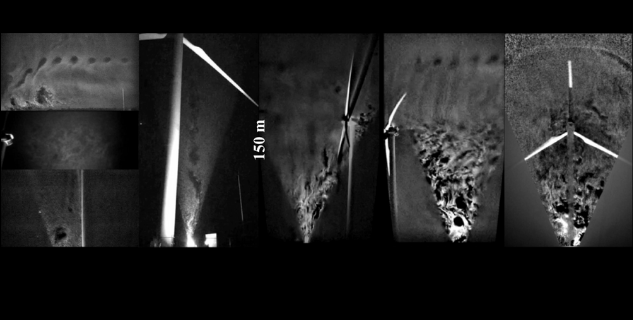SAFL atmospheric research groups gear up for winter projects

As snowflakes start to swirl outside this Minnesota winter season, several SAFL research groups are getting ready to take advantage of the weather to help advance fundamental atmospheric research.
Jiarong Hong, Associate Professor in the Department of Mechanical Engineering, and his research group have been using snowstorms since 2012 as a means to visualize the movement and behavior of air behind wind turbines. Studying the ‘near-wake’ of turbines at the field scale is unprecedented, and such data helps improve understanding of how the wake of one turbine can impact a turbine ‘downwind,’ helping fill a critical research gap when trying to improve the efficiency and performance of wind farms.
The visualization technique that Hong developed is called super-large-scale particle image velocimetry (SLPIV). Essentially, by shooting a beam of light up into the sky and illuminating tracer particles (in this case, snowflakes) in a 2D plane, researchers are able to quantify and map turbulence structures in the atmosphere. When Hong first developed the technique, his group was able to map turbulence structures up to 40 meters from the ground (the research was eventually featured in this Nature Communications article). More recently, Hong and his group have been able to modify the technique so it can capture turbulence structures from the ground to over 100 meters in the sky (larger than the size of a football field).
This winter season, Hong’s group, in collaboration with several other SAFL research groups, will focus on four types of fundamental research involving snow. Two of the projects use snow as a tracer particle for mapping atmospheric turbulence, while the last two focus on the behavior and dynamics of the snowflakes themselves.
Probing turbine-flow interaction and turbine wake at utility scale
SAFL Research Group involved: Jiarong Hong
Work continues to better understand the wake dynamics behind wind turbines, using the Eolos wind energy research field station near Rosemount, MN. Recent research by graduates of Hong’s group suggests that detailed information of turbine operation and response can lead to more predictable patterns of turbulence and wake behavior – a novel insight to enhance the control of current wind turbines and wind farms to improve overall performance (read more here). This winter the group will conduct SLPIV experiments at different distances and angles around the turbine to further investigate the interaction between the turbine and incoming wind as well as the impact of such interactions on downstream wake behaviors.
Understanding flow behavior in the atmospheric surface layer
SAFL Research Groups involved: Jiarong Hong, Michele Guala, Filippo Coletti
SAFL researchers also are interested in understanding turbulence and behavior of what is referred to as the ‘atmospheric surface layer’ of the atmosphere – essentially the section of atmosphere from the surface of the earth to a height of approximately 100 meters. This winter, researchers will use snow PIV to map the turbulent flow characteristics and coherent structures within the atmospheric surface layer. Results of such fundamental research will help improve our understanding of the patterns and structures of turbulence in the atmosphere, including how such patterns are generated and how they evolve with time and distance.
Studying snow settling behavior
SAFL Research Groups involved: Jiarong Hong, Michele Guala, Filippo Coletti
How does snow fall and settle on the ground? How do individual snowflake properties (e.g. morphology, permeability and porosity, etc.) as well as atmospheric turbulence influence its fall speed and the path it takes to the ground? Researchers will be using PIV in the field this winter to track the paths of millions of individual snowflakes as they fall to the ground. Furthermore, using a holographic technique, researchers will be able to capture the morphology and size distribution of those snowflakes as they fall. Such information will be incorporated into the design of well-controlled lab experiments using the ‘turbulence box’ at the St. Anthony Falls Laboratory with 3D-printed snow mimics to further elucidate the underlying physical mechanisms that govern snowflake settling dynamics. Results of the study could eventually be used to help improve the forecast of snowfall accumulation under different weather conditions.
Investigating snow drifting
SAFL Research Groups involved: Jiarong Hong, Michele Guala, Filippo Coletti
As fresh snow settles on the ground, frequently wind can pick up or entrain those snowflakes and move them across the earth’s surface, where they can form snow drifts. This winter, researchers are going to use field PIV to track snow particles after they settle on the ground and then are again entrained and transported across the earth’s surface.
Funding for the projects above include:
- National Science Foundation CAREER award: “Tackling Fluid Dynamics at Full Scale for Wind Energy Applications” Proposal No: 1454259
- Xcel Energy award: “Virtual Wind Simulator with Advanced Control & Aeroelastic Model for Improving the Operation of Wind Farms” Proposal No: RD4-13
- Institute on the Environment, University of Minnesota award: “Simulation, Measurement, Modeling, and Control of Wind Plant Power”
- National Science Foundation award: "Collaborative Research: Effects of Air Turbulence and Snowflake Morphology on Snow Fall Speed" Proposal No: 1822268
Project-related publications:
- Dasari, T., Wu, Y., Liu, Y., & Hong, J. (2019). Near-wake behaviour of a utility-scale wind turbine. Journal of Fluid Mechanics,859, 204-246. doi:10.1017/jfm.2018.779
- Heisel, M., Dasari, T., Liu, Y., Hong, J., Coletti, F., & Guala, M. (2018). The spatial structure of the logarithmic region in very-high-Reynolds-number rough wall turbulent boundary layers. Journal of Fluid Mechanics, 857, 704-747. doi:10.1017/jfm.2018.759Nemes, A.,
- Nemes, A., Dasari, T., Hong, J., Guala, M., & Coletti, F. (2017). Snowflakes in the atmospheric surface layer: Observation of particle–turbulence dynamics. Journal of Fluid Mechanics, 814, 592-613. doi:10.1017/jfm.2017.13
- Hong, J., Toloui, M., Chamorro, L. P., Guala, M., Howard, K., Riley, S., ... & Sotiropoulos, F. (2014). Natural snowfall reveals large-scale flow structures in the wake of a 2.5-MW wind turbine. Nature Communications, 5. doi: 10.1038/ncomms5216
